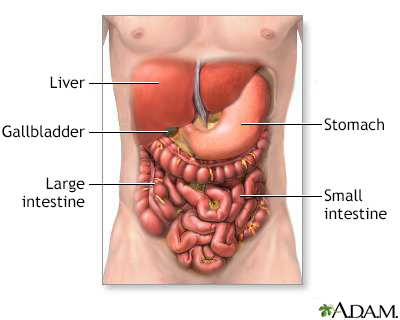Fecal fat
Quantitative stool fat determination; Fat absorption
The fecal fat test measures the amount of fat in the stool. This can help gauge the percentage of dietary fat that the body does not absorb.
Images

I Would Like to Learn About:
How the Test is Performed
There are many ways to collect the samples.
- For adults and children, you can catch the stool on plastic wrap loosely placed over the toilet bowl and held in place by the toilet seat. Then put the sample in a clean container. One test kit supplies a special toilet tissue that you use to collect the sample, then put the sample in a clean container.
- For infants and children wearing diapers, you can line the diaper with plastic wrap. If the plastic wrap is placed properly, you can prevent mixing of urine and stool. This will provide a better sample.
Collect all stool that is released over a 24-hour period (or sometimes 3 days) in the containers provided. Label the containers with name, time, and date, and send them to the lab.
Sometimes you will be asked to provide a single stool sample to be examined under a microscope for stool fat.
How to Prepare for the Test
Eat a normal diet containing about 100 grams (g) of fat per day for 3 days before starting the test. The health care provider may ask you to stop using medicines or food additives that could affect the test.
How the Test will Feel
The test involves only normal bowel movements. There is no discomfort.
Why the Test is Performed
This test evaluates fat absorption to tell how well the liver, gallbladder, pancreas, and intestines are working.
Fat malabsorption can cause a change in your stools called steatorrhea. To absorb fat normally, the body needs bile from the gallbladder (or the liver if the gallbladder has been removed), enzymes from the pancreas, and a normal small intestine.
Normal Results
Less than 7 g of fat per 24 hours.
What Abnormal Results Mean
Decreased fat absorption may be caused by:
- Biliary tumor
- Biliary stricture
- Celiac disease (non-tropical sprue)
- Chronic pancreatitis
- Crohn disease
- Cystic fibrosis
- Gallstones (cholelithiasis)
- Pancreatic cancer
- Pancreatitis
- Radiation enteritis
- Short bowel syndrome (for example from surgery or an inherited problem)
- Small bowel bacterial overgrowth
- Whipple disease
Risks
There are no risks.
Considerations
Factors that interfere with the test are:
- Enemas
- Laxatives
- Mineral oil
- Inadequate fat in diet prior to and during the stool collection
Related Information
MalabsorptionBile
Cancer
Bile duct stricture
Celiac disease – sprue
Gallstones
Chronic pancreatitis
Crohn disease
Cystic fibrosis
Pancreatic cancer
Radiation enteritis
Short bowel syndrome
Whipple disease
References
Höegenauer C, Hammer HF. Maldigestion and malabsorption. In: Feldman M, Friedman LS, Brandt LJ, eds. Sleisenger and Fordtran's Gastrointestinal and Liver Disease. 11th ed. Philadelphia, PA: Elsevier; 2021:chap 104.
Semrad CE. Approach to the patient with diarrhea and malabsorption. In: Goldman L, Cooney KA, eds. Goldman-Cecil Medicine. 27th ed. Philadelphia, PA: Elsevier; 2024:chap 126.
BACK TO TOPReview Date: 8/12/2024
Reviewed By: Jenifer K. Lehrer, MD, Gastroenterologist, Philadelphia, PA. Review provided by VeriMed Healthcare Network. Also reviewed by David C. Dugdale, MD, Medical Director, Brenda Conaway, Editorial Director, and the A.D.A.M. Editorial team.

Health Content Provider
06/01/2025
|
A.D.A.M., Inc. is accredited by URAC, for Health Content Provider (www.urac.org). URAC's accreditation program is an independent audit to verify that A.D.A.M. follows rigorous standards of quality and accountability. A.D.A.M. is among the first to achieve this important distinction for online health information and services. Learn more about A.D.A.M.'s editorial policy, editorial process and privacy policy. A.D.A.M. is also a founding member of Hi-Ethics. This site complied with the HONcode standard for trustworthy health information from 1995 to 2022, after which HON (Health On the Net, a not-for-profit organization that promoted transparent and reliable health information online) was discontinued. |
The information provided herein should not be used during any medical emergency or for the diagnosis or treatment of any medical condition. A licensed medical professional should be consulted for diagnosis and treatment of any and all medical conditions. Links to other sites are provided for information only -- they do not constitute endorsements of those other sites. © 1997- 2025 A.D.A.M., a business unit of Ebix, Inc. Any duplication or distribution of the information contained herein is strictly prohibited.
